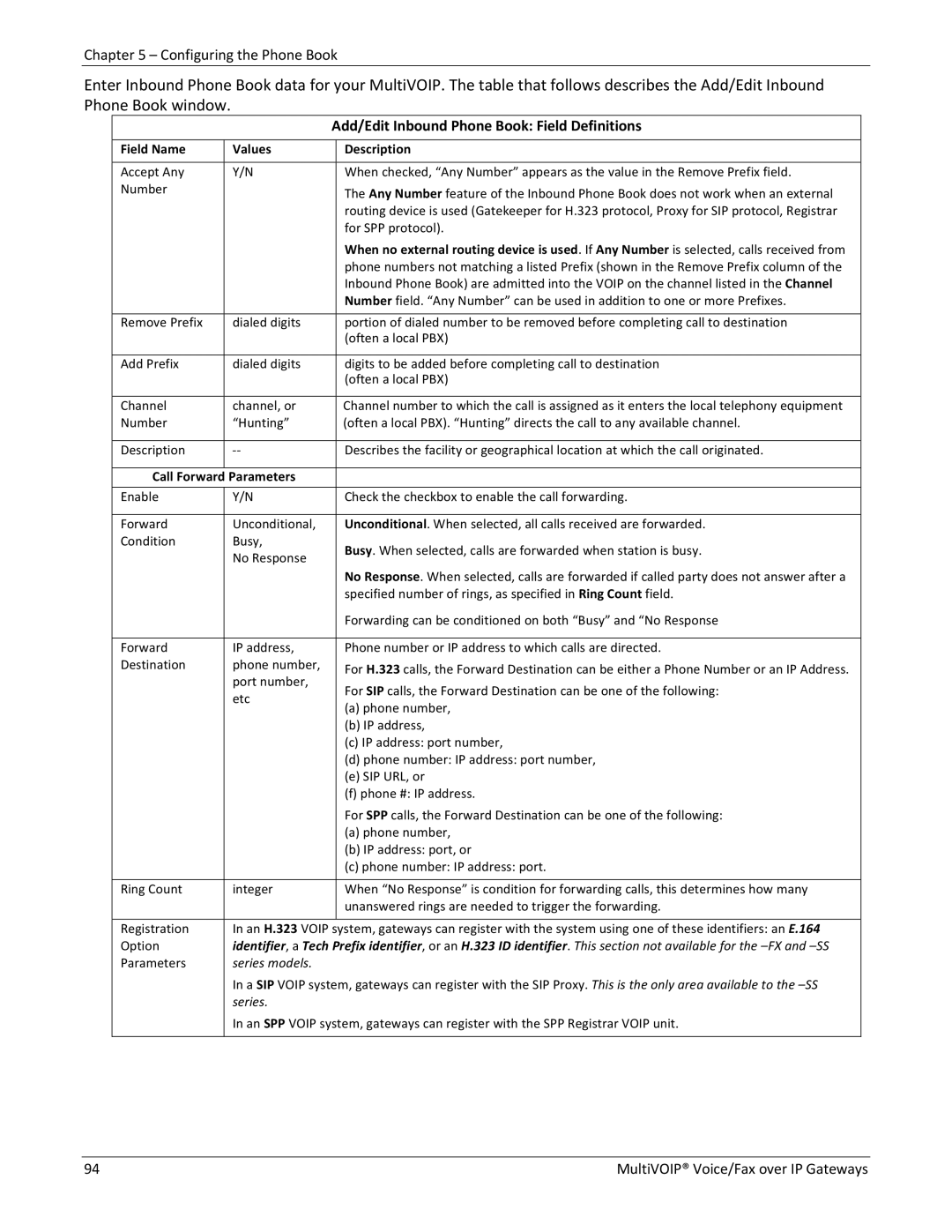
Chapter 5 – Configuring the Phone Book
Enter Inbound Phone Book data for your MultiVOIP. The table that follows describes the Add/Edit Inbound Phone Book window.
Add/Edit Inbound Phone Book: Field Definitions
Field Name | Values | Description |
|
|
|
Accept Any | Y/N | When checked, “Any Number” appears as the value in the Remove Prefix field. |
Number |
| The Any Number feature of the Inbound Phone Book does not work when an external |
|
| |
|
| routing device is used (Gatekeeper for H.323 protocol, Proxy for SIP protocol, Registrar |
|
| for SPP protocol). |
|
| When no external routing device is used. If Any Number is selected, calls received from |
|
| phone numbers not matching a listed Prefix (shown in the Remove Prefix column of the |
|
| Inbound Phone Book) are admitted into the VOIP on the channel listed in the Channel |
|
| Number field. “Any Number” can be used in addition to one or more Prefixes. |
|
| portion of dialed number to be removed before completing call to destination |
Remove Prefix | dialed digits | |
|
| (often a local PBX) |
|
| digits to be added before completing call to destination |
Add Prefix | dialed digits | |
|
| (often a local PBX) |
|
| Channel number to which the call is assigned as it enters the local telephony equipment |
Channel | channel, or | |
Number | “Hunting” | (often a local PBX). “Hunting” directs the call to any available channel. |
|
| Describes the facility or geographical location at which the call originated. |
Description | ‐‐ | |
|
|
|
Call Forward | Parameters |
|
Enable | Y/N | Check the checkbox to enable the call forwarding. |
|
| Unconditional. When selected, all calls received are forwarded. |
Forward | Unconditional, | |
Condition | Busy, | Busy. When selected, calls are forwarded when station is busy. |
| No Response | |
|
| |
|
| No Response. When selected, calls are forwarded if called party does not answer after a |
|
| specified number of rings, as specified in Ring Count field. |
|
| Forwarding can be conditioned on both “Busy” and “No Response |
|
| Phone number or IP address to which calls are directed. |
Forward | IP address, | |
Destination | phone number, | For H.323 calls, the Forward Destination can be either a Phone Number or an IP Address. |
| port number, | |
| For SIP calls, the Forward Destination can be one of the following: | |
| etc | |
| (a) phone number, | |
|
| |
|
| (b) IP address, |
|
| (c) IP address: port number, |
|
| (d) phone number: IP address: port number, |
|
| (e) SIP URL, or |
|
| (f) phone #: IP address. |
|
| For SPP calls, the Forward Destination can be one of the following: |
|
| (a) phone number, |
|
| (b) IP address: port, or |
|
| (c) phone number: IP address: port. |
|
|
|
Ring Count | integer | When “No Response” is condition for forwarding calls, this determines how many |
|
| unanswered rings are needed to trigger the forwarding. |
|
|
|
Registration | In an H.323 VOIP system, gateways can register with the system using one of these identifiers: an E.164 | |
Option | identifier, a Tech Prefix identifier, or an H.323 ID identifier. This section not available for the | |
Parameters | series models. |
|
| In a SIP VOIP system, gateways can register with the SIP Proxy. This is the only area available to the | |
| series. |
|
| In an SPP VOIP system, gateways can register with the SPP Registrar VOIP unit. | |
|
|
|
94 | MultiVOIP® Voice/Fax over IP Gateways |
